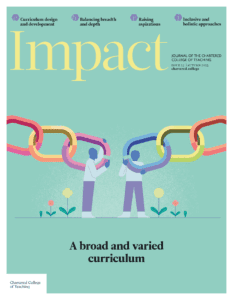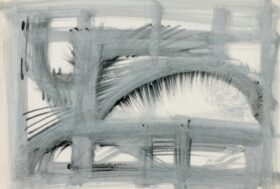Specialist arts teachers make a difference

PAT THOMSON AND CHRISTINE HALL, SCHOOL OF EDUCATION, UNIVERSITY OF NOTTINGHAM, UK
Arts education is a required component of the National Curriculum in England. There are, however, no national statistics that show whether primary arts education is affected by the same decline as secondary arts enrolments (Cultural Learning Alliance, 2025). While all primary schools are expected to cover music and art and design, the vast majority of classroom teachers do not have specialist arts knowledge. A primary classroom teacher’s arts repertoire draws on a complex mix of their own prior arts experience, their initial teacher education programme and the quality of their school teaching experience, including how much formal and informal professional development is available (Hennessy et al., 2001).
Teachers in England cannot rely on initial teacher education for a solid arts education. Recent research into arts provision in primary initial teacher education showed that while some universities provided specialist arts modules (Hennessy, 2017), the average arts provision was only four hours in total; teacher educators reported having to choose between offering foundational principles or some activities to get started with (Thomson et al., 2025). Most primary schools do have access to Music Hubs, but these are generally not able to offer immersive and continuing professional learning support for classroom music. And the national report ‘Art now’ (All Party Parliamentary Group for Art, Craft and Design Education, 2023) suggests that only a quarter of the teachers responsible for art and design in their school had attended some subject-specific professional development that year, while 21 per cent said that they had had no professional learning in the subject since initial teacher education. It is therefore hardly surprising that primary teachers consistently report a lack of confidence in teaching the arts (Cain et al., 2024; Holden and Button, 2006) and that the specialist arts teachers who do exist can experience lack of agency and difficulties in finding support and collegiality as they take on the job of ensuring access to the arts within a school (Chapman et al., 2019).
There are, however, primary schools that work against this trend. This paper draws on the RAPS (Researching the Arts in Primary Schools) project, which investigated the practices of 76 arts-rich schools (Thomson et al., 2025) to show how specialist arts teachers working in an arts-encouraging environment can support generalist primary teachers to teach the arts confidently and knowledgeably. The RAPS schools all offered art and music to all children every week, every year. They also offered other arts subjects, with drama, dance and creative writing being nearly as frequent as art and music. Eighty per cent of schools had specialist music teachers; 52 per cent had specialist art teachers.
All the 40 schools that we selected for further case study research had at least one specialist teacher – many had more – and they represent the full variety of art forms, with music, art and drama being the most common. Most of the case study schools had arts leads as middle leaders, but in some, the arts specialist was part of the senior leadership team. In a few cases, the heads themselves were arts leads. The organisation of specialist staff also varied. Some schools had a clear hierarchy, with a coordinating arts lead overseeing specialist leads in each art form. Others had a flatter model with collaborative arts teams, where arts leadership was spread among staff. These differences reflected school size, staffing, school history and headteacher preferences. Around 60 per cent of the arts specialists in the RAPS case study schools had formal arts qualifications; many had professional arts backgrounds and still continued leading and/or singing in choirs, doing session musician work, working as arts/music consultants, running comedy nights, acting, devising plays, painting, drawing, taking photographs or running community arts events.
Specialist arts staff change what generalist teachers do and feel
Specialist staff are, by definition, highly skilled practitioners. They possess pedagogical content knowledge (PCK) (Shulman, 1986). PCK refers to teacher capacity to effectively teach specific subject material to a particular group of students, taking into account their prior knowledge and misconceptions. PCK brings together subject (content) knowledge, curriculum knowledge (which knowledge and skills are important, how they are to be coherently organised and sequenced), knowledge about education in general and children (particularly understanding the specific children in the class and school), and pedagogical knowledge (texts, tasks and activities, methods, pacing and assessment). PCK is developed through experience, reflection and continuing professional development (CPD). Teachers use their PCK resources when they anticipate student difficulties, select appropriate examples and materials, and adapt their teaching strategies to meet the needs of individual learners.
The pedagogical content knowledge of arts specialists was key to the arts-richness of the schools that we studied. Although each RAPS school had its unique structure and context, there were six common aspects of the arts lead role:
- Curriculum design and progression: Arts leads led the design and implementation of a coherent, progressive curriculum in their art form. If they were lead across arts, this responsibility extended across the arts domain. They mapped the key knowledge, skills and experiences that students should encounter from early years to Year 6. They generally created detailed progression documents for each year group, ensuring that students built systematically on their learning, increasing mastery over time.
- Classroom teacher development and support: Arts leads provided training, guidance and support to enable all classroom teachers to teach the arts effectively. They led whole-staff CPD sessions, provided resources and lesson plans if needed and offered individual coaching and mentoring. Most also team-taught, working closely with class teachers to co-plan and co-teach lessons, gradually releasing responsibility as staff gained confidence and skills. In some schools, arts leads ran drop-in sessions for staff to practise techniques and build confidence.
- Resourcing and budgeting: Arts leads were generally responsible for managing the arts budget. They sourced and procured diverse resources, equipment and facilities to support teaching and learning. They kept a close eye on resources, ensuring that equipment was maintained in good condition, and facilitated access to musical instruments and high-quality materials for all children.
- Partnerships and enrichment: Arts leads were generally the key contact for establishing and maintaining partnerships with arts organisations, cultural venues and practitioners. They actively sought out opportunities to enrich the curriculum through visits, workshops, residencies and performances. Many of the RAPS schools had long-term partnerships, which the arts leads sustained and sometimes extended.
- Showcasing and celebrating: Arts leads led the development of opportunities for students to share and celebrate their artistic achievements; they organised exhibitions, concerts, productions and community events. Many of the schools had arts weeks and ambitious concerts and recitals, often in prestigious venues. These were important highlights in the regular arts learning timetable.
- Advocacy: Arts leads advocated for the value and importance of the arts within their school and beyond. They made the case to governors, parents and the wider community for the impact of the arts on students’ learning, wellbeing and personal development. Some arts leads were active on social media and in professional arts organisations.
Together, this specialist teacher practice significantly changed generalist classroom arts teaching. In striking contrast to published research (Bowen and Kisida, 2021; Wilson et al., 2008), RAPS schools’ classroom teachers taught a range of arts subjects and felt comfortable doing so. Our survey of classroom teachers showed only eight per cent who taught no arts at all. The most common subjects taught by generalist teachers were drawing and painting (86 per cent of teachers), singing (83 per cent) and creative writing (76 per cent). The majority of teachers (over 50 per cent) taught singing for productions, musicals and/or choirs, dance, drama, sculpting and 3D art, textiles, and other visual arts. A third of generalist teachers were teaching ceramics. Nearly a third (31 per cent) of teachers were teaching digital arts, such as animation and GarageBand, while nearly one in 10 were teaching children to make films and videos. One in 10 were also teaching ‘other media’, such as audio recording, using a radio studio and/or making podcasts.
We asked teachers how much time they spent on arts subjects each week. Just over half (53 per cent) taught an arts subject for between 30 and 60 minutes each week. Around a quarter (23 per cent) taught arts for between 60 and 90 minutes each week. One in 10 teachers (10 per cent) taught arts for more than 90 minutes each week. They may, of course, have also spent additional time on arts in integrated themes or topics.
We asked teachers about sources and resources for lessons and projects (Figure 1). The majority of classroom teachers confirmed that arts leads were their greatest source of teaching resources.
Figure 1: Sources of lesson plans and ideas
We also asked teachers about their own arts subject learning. Fifteen per cent had never had any formal CPD in arts teaching. The remainder had all had some formal CPD, most commonly either once a year (38 per cent of teachers) or every term (31 per cent). However, the vast majority reported having informal CPD through sharing resources, observation, co-teaching and being observed. The frequency of teachers’ informal support for the arts as a whole matched the patterns seen for their formal support, with termly (33 per cent) and yearly (32 per cent) support being the most common. Our survey also canvassed teachers’ views of their own competence in teaching arts on a scale of one to 10. Most teachers rated themselves as a seven (29 per cent) or an eight (27 per cent). One in five (20 per cent) rated themselves as either a nine or a 10. This is a very different picture to previous research.
Conclusion
We know that generalist primary teachers tend to lack confidence in teaching the arts. The RAPS research provides compelling evidence that a well-planned combination of team teaching, coaching, specialist-created resources and targeted training can significantly improve this situation, enhancing generalist teachers’ capacity to deliver effective arts education even if, initially, they lack confidence and a specialist background. Our case studies show that schools that prioritise collaborative professional development to enhance and share pedagogical content knowledge are likely to be more successful in embedding arts across the curriculum and building an arts-rich culture.
The policy implications are obvious: we urgently need to recruit, train and employ more specialist arts teachers in our primary schools.
- All Party Parliamentary Group for Art Craft and Design Education (2023) Art now: An inquiry into the state of art and design teaching in Early Years Foundation Stage, primary and secondary education. NSEAD. Available at: www.nsead.org/files/f390916bfc129004ad8b73145db1fe75.pdf (accessed 21 July 2025).
- Bowen DH and Kisida B (2021) The arts advantage: Impacts of arts education on Boston students. Available at: www.edvestors.org/wp-content/uploads/2021/04/The-Arts-Advantage-Impacts-of-Arts-Education-on-Boston-Students.pdf (accessed 21 July 2025).
- Cain M, Burke K and Nislev E (2024) When constellations align: What early childhood pre-service teachers need from online learning to become confident and competent teachers of the arts. British Educational Research Journal 50: 331–347.
- Chapman S, Wright P and Pascoe R (2019) ‘I’m really worried for my teaching spirit’: Professional agency, curriculum change and the primary arts specialist teacher. Journal of Curriculum Studies 52(4): 577–592.
- Cultural Learning Alliance (2025) Report card 2025. Available at: www.culturallearningalliance.org.uk/wp-content/uploads/2025/03/CLA-2025-Report-Card_AW.pdf (accessed 21 July 2025).
- Hennessy S (2017) Approaches to increasing the competence and confidence of student teachers to teach music in primary schools. Education 3–13 45(6): 689–700.
- Hennessy S, Rolfe L and Chedzoy S (2001) The factors which influence student teachers’ confidence to teach the arts in the primary classroom. Research in Dance Education 2(1): 53–71.
- Holden H and Button S (2006) The teaching of music in the primary school by the non-music specialist. British Journal of Music Education 23(1): 23–38.
- Shulman L (1986) Those who understand: Knowledge growth in teaching. Educational Researcher 15(2): 4–14.
- Thomson P, Hall C and Maloy L (2025) The RAPS Project: Researching the Arts in Primary Schools. University of Nottingham and Freelands Foundation. Available at: https://artsprimary.com/wp-content/uploads/2025/02/raps-final-feb-2025--4.pdf (accessed 21 July 2025).
- Wilson GB, Macdonald RAR, Byrne C et al. (2008) Dread and passion: Primary and secondary teachers’ views on teaching the arts. Curriculum Journal 19(1): 37–53.











